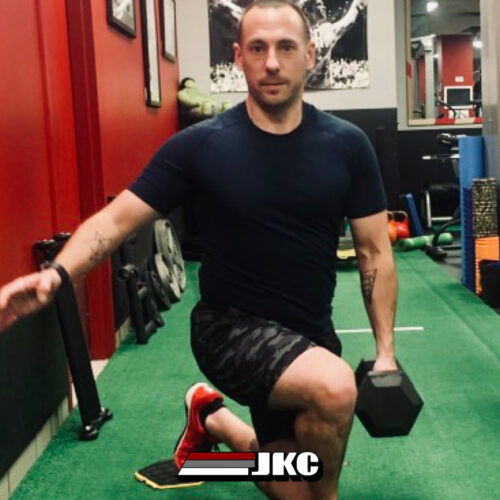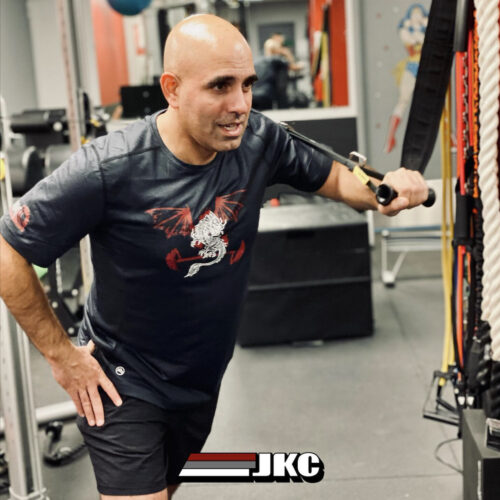
A brand new study in the European Journal of Applied Physiology looked at the neuromuscular adaptations during combined strength and endurance training in endurance runners (Taipale, Mikkola, Vesterinen, Nummela & Hakkinen, 2012).
This study is out of the University of Jyvaskyla in Finland.
This study compared the effects of 1) mixed maximal strength training & explosive strength training with 2) maximal (not mixed) strength training & 3) explosive strength training when combined with endurance training (running).
Subjects, study design and training
The intervention took place over 8-weeks. All subjects (n=37) were male recreational endurance runners (21-45 years in age) and were divided into 4-groups:
- maximal strength training (MAX) (n=11)
- explosive (EXP) (n=10)
- mixed maximal & explosive (MIX) (n=9)
- circuit training control group (CON) (n=7)
The subjects had no previous strength training experience aside from a 6-week period of preparatory training (consisting of 50 to 70% 1 repetition maximum – 1RM), which was completed prior to the strength training intervention.
The Intervention(s)
Strength training (and circuit training) was performed 1 to 2-times per week (supervised); whereas, endurance (running) training was performed 3 to 4-times per week. Endurance sessions (heart rate monitored) were performed on non-strength training days at an intensity below lactate threshold (pre-determined).
Endurance training volume was (in km and individualized based on training background and current fitness level):
- 42.6 + 30.5 for MAX
- 40.7 + 30.5 for EXP
- 33.0 + 28.5 for MIX
- 25.5 + 22.0 for CON
Total endurance training time per week was 5:38 + 0.56 hours; therefore, the researches were able to claim relative volume and intensity was similar.
Strength and explosive sessions were preceded with 20 to 30-minutes of low-intensity cardio and warm-up sets with sub maximal loads (squat and leg press exercise). 2 to 3-minutes break was given in between exercise sets for all the three strength and/or explosive training groups.
The circuit training group (control) performed a circuit of body weight squats, pushups, lunges, sit-ups, toe raises, back-ups, planks and step-ups in series – 45-sec work followed by 15-sec rest during the first 4 weeks and 50-sec work followed by 10-sec rest in the last 4-weeks. The researchers claim that this protocol was meant to improve muscular endurance, not strength.
Measurements
Measurements included body composition, aerobic capacity, isometric leg press strength, 1RM horizontal leg press, countermovement jump, EMG, and serum hormones.
Findings
Significant increases were seen in maximal dynamic strength (1RM), countermovement jump performance (power measure) and maximal muscle activation during the 1RM in the maximal strength training group.
Countermovement jump improved significantly in the explosive training group. Peak running speed and running speed at respiratory compensation threshold improved significantly in the maximal strength training group, explosive training group and mixed maximal & explosive training groups without a significant change in VO2-max or running economy.
Despite the fact that no improvements were made to VO2-max and running economy, the researchers indicate that improvements in peak running speed and running speed at respiratory compensation threshold still suggest improvements in endurance performance.
The significant changes in strength (1RM) and power (countermovement jump) were primarily observed during the first 4-weeks of the intervention and plateaued over the final 4-weeks – the researches attribute this plateau to the fact that the subjects participated in a 6-week pre-intervention strength training protocol (therefore, 10-weeks of strength training). The researches note that the improvements in strength over the 8-week period only averaged 3.5% – relatively low compared to inexperienced subjects participating in a strength-training-only intervention (10 to 20% increases are normally seen in this population).
No significant changes were seen in maximal isometric strength (isometric leg press) and muscle activation, rate of force development, maximal oxygen uptake (VO2) and running economy (at 10 and 12-km/hour).
“Improvements in strength and power appear to be highly individual, thus performing the more diverse mixture of maximal and explosive strength training in a way that meets individual needs may be more effective than maximal or explosive strength training combined with endurance training alone.”
Taipale et al.
In the circuit training control group, no significant changes were observed in maximal isometric strength, rate of force development, running economy, countermovement jump performance or muscle activation. Actually, a significant decrease in 1RM was seen in the final 4-weeks of training. This implies that the circuit training combined with the endurance training was not enough of a training stimulus to maintain or improve maximal strength. However, significant improvements were seen in peak running speed, running speed at respiratory compensation threshold and VO2-max. Due to the aerobic nature of circuit training, the researchers suggest that this may be a reason why this group saw an improvement in VO2-max (remember, they were only recreational runners; therefore, instead of doing only 4 aerobic workouts per week, they were actually doing 6 if you include the circuit training sessions).
The researchers state that low volume maximal strength training, explosive training or mixed maximal strength training & explosive training, when combined with a high(er) volume endurance (running) training program over an 8-week intervention period resulted in significant gains in strength, power and endurance performance measures (peak running speed & running speed at respiratory compensation threshold). The researchers add that these 3 protocols appear to be more effective than circuit training at increasing and maintaining maximal strength and explosive power. Muscle hypertrophy was not taken into account in this study; however, the researchers suggest that early adaptations (neural) caused by maximal strength and explosive-type training might explain the improvements seen in muscle activation during the dynamic 1RM (maximal strength training group) and countermovement jump (explosive training group).
The take home message(s)
Strength training can be attributed to either an increase in muscle cross sectional area and/or via neuromuscular acclimations (obviously, we know which result you runners want). Previous studies have linked strength training (in combination with endurance-type training) with improved performance economy (e.g. running and cross country skiing) in both males and females and in trained and un-trained populations.
Performance economy essentially means improvement in voluntary muscle activation (leading to increases in strength and power production), which is associated with an increase in speed and reduced oxygen consumption (cost).
Circuit training with body weight exercises (and no explosive exercises) does not appear to be helpful for improving overall strength and running speed. It can be extrapolated that the weight used (body weight) was not enough of a training stimulus to elicit improvements in strength. However, circuit training may improve aerobic capacity in runners with a lower VO2-max; therefore, benefiting their running.
Mixed strength training and explosive training, strength training alone and explosive training alone appear to be helpful in improving overall strength and power development in runners (recreational only running less than lactate threshold). Unfortunately, most running programs for runners incorporate higher paced running (greater than lactate threshold) to elicit improvements in the aerobic system. It would have been interesting to see how this type of strength training breakdown (MAX, EXP, MIX) would apply to those running with a higher running volume and to those who also incorporate more faster paced running.
Thanks for reading. I hope you found this info helpful.
-JK
References
Taipale, R.S., Mikkola, J., Vesterinen, V., Nummela, A., and Hakkinen, K. (2012). Neuromuscular adaptations during combined strength and endurance training in endurance runners: Maximal versus explosive strength training or a mix of both. Eur J of Appl Phys. Epub ahead of print.








































